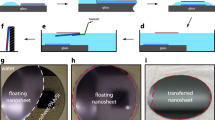Abstract
Nano-size crystals of molecular conductors have been directly formed on SiO2/doped-Si substrates. Two kinds of methods were used for this on-site crystal growth, one of which is electrochemical crystallization on electrodes prepared on the substrate, and the other of which is direct reaction of metal copper or silver electrodes with acceptor molecules such as DCNQI (= N,N′-Dicyanobenzoquinonediimine) derivatives on the substrate. In both cases, we have succeeded in bridging two or more electrodes with the single crystal of the molecular conductors. Temperature dependence of the resistivity often exhibited significantly different behaviors from those of the corresponding bulk crystals. Origins of the unusual behaviors of the nanocrystals are discussed.
Similar content being viewed by others
References
N. Tajima, J. Fujisawa, N. Naka, T. Ishihara, R. Kato, Y. Nishio, and K. Kajita,J. Phys. Soc. Jpn,74, 511 (2005).
M. Chollet, L. Guerin, N. Uchida, S. Fukaya, H. Shimoda, T. Ishikawa, K. Matsuda, T. Hasegawa, A. Ota, H. Yamochi, G. Saito, R. Tazaki, S. Adachi, and S. Koshihara,Science,307, 86 (2005).
H. Yamochi, T. Haneda, A. Tracz, J. Ulanski, O. Drozdova, K. Yakushi, and G. Saito,J. Phys. IV,114, 591 (2003).
T. Ishiguro, K. Yamaji, G. Saito,Organic Superconductors, Springer: Berlin, (1997)
P. Monceau, F. Nad, and S. Brazovskii,Phys. Rev. Lett,86, 4080 (2001).
N. Hanasaki, H. Tajima, M. Matsuda, T. Naito, T. Inabe,Mol. Cryst. Liq. Cryst. 343, 41 (2000).
J. S. Brooks,Adv. Materials Opt. Elec,8, 269 (1998)
T. Hasegawa, K. Mattenberger, J. Takeya, and B. Batlogg,Phys. Rev. B,69, 245115 (2004)
R. Kato,Bull. Soc. Chem. Jpn. 73, 515 (2000) and references cited therin.
K. Bechgaard, C.S. Jacobsen, K. Mortensen, H.J. Pedersen, N Thorup,.Solid State Commun. 33, 1119 (1980)
K. Bender, I. Hennig, D. Schweizer, K. Dietz, H. Endres, and H. J. Keller,Mol. Cryst. Liq. Cryst. 108, 359 (1984).
A. Ota, H. Yamochi, G. Saito,J. Materials Chem,12, 2600 (2002).
H. M. Yamamoto, J. -I. Yamaura, R. Kato,J. Amer. Chem. Soc. 120, 5905 (1998).
Author information
Authors and Affiliations
Rights and permissions
About this article
Cite this article
Yamamoto, H.M., Ito, H., Shigeto, K. et al. Nano-size molecular conductors on silicon substrate-Toward device integration of conductive CT salts-. J Low Temp Phys 142, 215–220 (2006). https://doi.org/10.1007/BF02679497
Issue Date:
DOI: https://doi.org/10.1007/BF02679497




